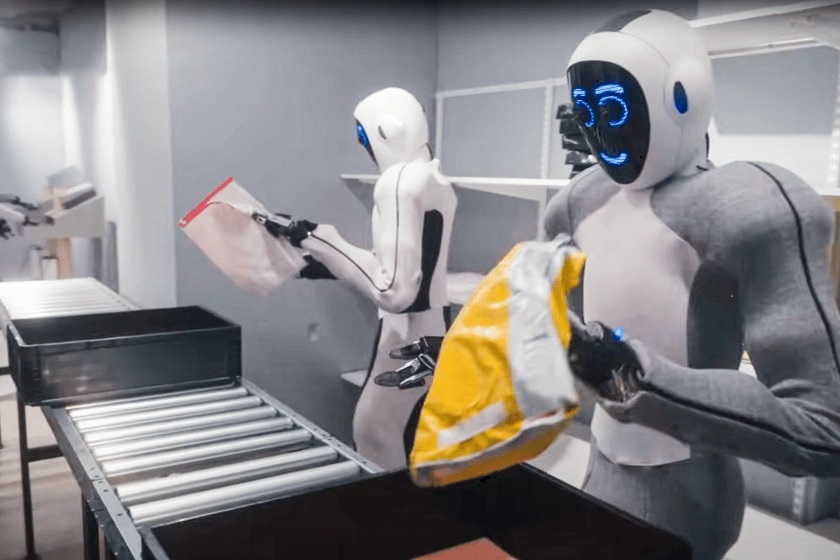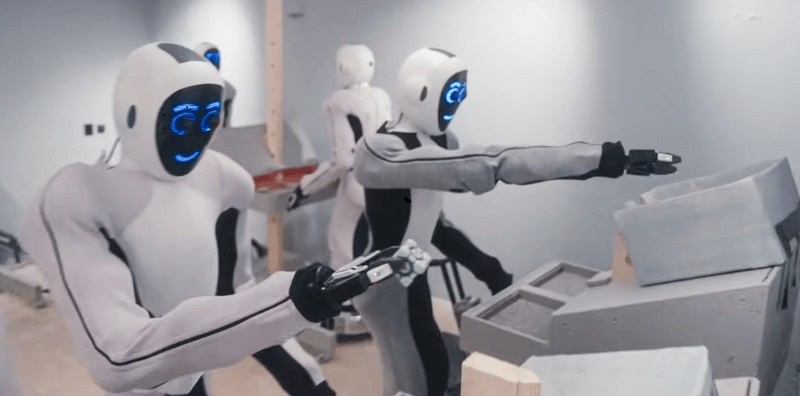
22 Feb OpenAI’s Eve humanoids make impressive progress in autonomous work
Eve humanoids, developmed by OpenAI, represent a significant advancement in the field of robotics and artificial intelligence. These humanoid robots are designed to operate autonomously, showcasing remarkable progress in their human intervention. The development of Eve humanoids marks a significant milestone in the quest for creating intelligent, adaptable machines capable of navigating comples environments and undertaking diverse tasks with precision and efficiency.
Table of Contents
Background and Development
The journey of Eve humanoids beings with the relevantless pursuit of innovation in robotics and AI by researches and engineers at OpenAI. Drawing inspiration from both biological systems and cutting-edge technological advancements. OpenAI embarked on a mission to develop humanoid robots that could emulate human-like capabilities while leveraging the power of artificial intelligence to enhance their autonomy.
The development process involved a multidisciplinary approach, combining expertise in robotics, machine learning, computer vision, and cognitive science. Researchers worked tirelessly to overcome numerous technical challenges, including locomotion, perception, manipulation, and decision-making, to create robots that could interact seamlessly with their surroundings and perform tasks with dexterity and efficiency.
Capabilities of Eve Humanoids
Eve humanoids boast an impressive array of capabilities that set them apart in the realm of autonomous robotics. Equipped with advanced sensors, actuators, and sophisticated algorithms, these robots demonstrate proficiency in various domains, ranging from navigation and object recognition to complex manipulation and interaction with the environments.
One of the key strengths of Eve humanoids lies in their ability to learn from their experiences and adapt to new situations autonomously. Through continuous interaction with their surroundings and feedback from their sensors, these robots can improve their performance over time, acquiring new skills and refining exciting ones without the need for explicit programming or human intervention.
Moreover, Eve humanoids exhibit a high degree of versatility, enabling them to perform a wide range of tasks across different domains. Whether it’s assisting in household chores, supporting industrial operations, or engaging in collaborative tasks with humans, these robots demostrate remarkable flexibility and adaptability, making them valuable assets in various real-world scenarios.
Advancements in Autonomous Word
Eve humanoids have made significant strides in the realm of autonomus work, thanks to ongoing research and development efforts aimed at enhancing their capabilities and performance. Leveraging state-of-the-art techniques in machine learning, computer vision, and robots to tackle increasingly complex tasks with a high degree of autonomy and efficiency.
Machine Learning Techniques
Machine learning plays a pivotal role in empoering Eve humanoids to learn from ttheir experiences and improve their decision-making abbilities overtime. Through techniques such as reinforcement learning and deep learning, these robots can analyze vast amounts of data, extract meaningful patterns, and make informed decisions in real-time.
Reinforcement learning algorithms enable Eve humanoids to learn optimal behavior by receiving feedback from their environment in the form of rewards or penalties. By exploring different actions and their consequences these robots can gradually refine their strategies and adapt to dynamic environments, thereby enhancing autonomy and efficiency in task execution.
Deep learning, on the other hand, enables Eve humanoids to process sensory inputs, such as images and sounds, and extract relevant information for perception and decision-making. Convolutional neural networks (CNNs) and recurrent neural networks (RNNs) are commonly used architectures for tasks such as object recognition, scene understanding, and natural language processing, enabling these robots to interact intelligently with their surroundings.
Computer Vision Techniques
Computer vision plays a crucial role in enabling Eve humanoids to perceive and interpret visual information from their environment. By equipping these robots with advances vision systems comprising cameras, depth sensors, and LiDARs, researches have enabled their surroundings, navigate autonomously, and interact with objects and humans effectively.
Object detection and recognition algorithms allow Eve humanoids to identify and classify objects in their environment, enabling them to perform tasks such as object manipulation, grasping, and navigation. By leveraging deep learning techniques, these robots can achieve high levels of accuracy and robustness in object detection, even in complex and cluttered environments.
Sematic segmentation techniques enable Eve humanoids to understand the spatial layout of their surroundings and distinguish between different objects and regions. By segmenting the scene into meaningful semantic categories, these robots can navigate intelligently and interact with objects in a purposeful manner, enhancing their autonomy and situational awareness.
Robotics Techniques
In addition to machine learning and computer vision, robotics techniques play a crucial role in enabling Eve humanoids to manipulate objects and interact with their environment physically. Kinematic and dynamic motion planning algorithms enable these robots to generate smooth and collision-free trajectories for reaching and grasping objects, allowing them to perform tasks with precision and efficiency.
Force and tactile sensing capabilities enable Eve humanoids to perceive and respond to physical interactions with objects and humans in their environment. By integrating sensor such as force/torque sensors and tactile sensors into their hands and fingers, these robots can exert appropriate forces adapt their grasp to different objects’ shapes, sizes, and properties, enabling them to manipulate objects delicately and securely.
Localization and mapping techniques enable Eve humanoids to build and maintain spatial representations of their environment, allowing them to navigate autonomously and perform tasks in synamic and unstructures environments. By fusing data from various sensors, such as cameras, LiDAs, and intertail meansurment units (IMUs), these robots can estimate their pose accurtely and update their maps in real-time, enabling robust and reliable navigation capabilities.

Practical Applications
The advancements in autonomous work achieved by Eve humanoids have paved the way for their deployment in various practical applications across different domains. From household assistance to industrial automation, these robots are revolutionizing the way we live, work, and interact with technology.
Household Assistance
In the realm of household assistance, Eve humanoids are poised to transform the way we manage our daily chores and routines. Equipped with capabilities such as object recognition, manipulation, and natural language processing, these robots can assist with tasks such as cooking, cleaning, and organizing, freeing up valuable time and resources for individuals and families.
Eve humanoids can navigate autonomously in indoor environments, avoiding abstrackes and moving safely among furniture and appliances. They can recognize and pick up objects, such as utensils, dishes, and groceries, and preparing meals human under human supervision.
Moreover, these robots can interact with users through natural language commands and responses, enabling seamless communication and collaboration in various household activities. Whether it’s reminding users of upcoming appointments, fetching items from different rooms, or entertaining children with educational games and stories, Eve humanoids can enhance the overall quality of life and convenience for individuals and families.
Industrial Automation
In the domain of industrial automation, Eve humanoids are revolutionizing manufacturing and production processes by augmenting human workers with intelligent robotic assistants. These robots can perform a wide range of tasks, including assembly, inspection, packaging, and logistics, with speed, precision, and constency, thereby improving productivity and efficency in manufacturing operations.
Eve humanoids can collaborate with human workers in shared workspaces, leveraging their autonomous capabilities to perform repetitive or physically demanding tasks while allowing humans to focus on more complex and cognitive aspects of the job. By working side by side with humans, these robots can enhance collaboration, safety, and flexibility in manufacturing environments, leading to better outcomes for businesses and workers alike.
Moreover, Eve humanoids can adapt to changing production requirements processes. Whether it’s adjusting assembly line configurations, reprogramming robotic tasks, or optimizing logistics workflows, these robots can contribute to .
The Continuous advancements in EVE humanoids technology signify a paradigm shiftin the landscape of autonomous works. As these robots evolse, they are poised to revolutionize various industries, offering unprecedented levels of efficency, safety, and scalability. However, alongside these displacement, privacy, and algorithmic to ensure responsible deployment and usage of autonomous system.
Final Throught:
OpenAI’s EVE humanoids represent a froundbreaking leap forward in the realm of autonomous work. With their remarkable progress and capabilities, these robots herald a future where human-robots collaboration redefines productivity and innovation across industries. As research and development efforts continue, the journey towards fully autonomous system by principles of safety, ethics, and inclusivity remains paramount, shaping a future where technology serves humanity in unprecedented ways.


No Comments